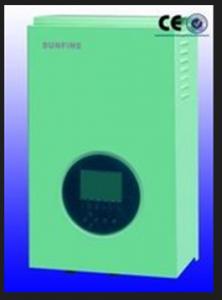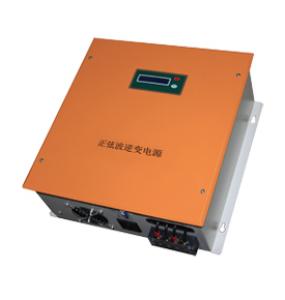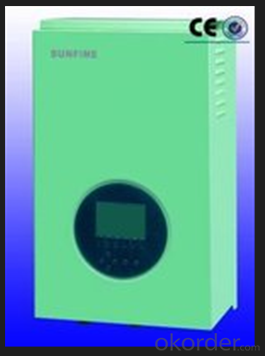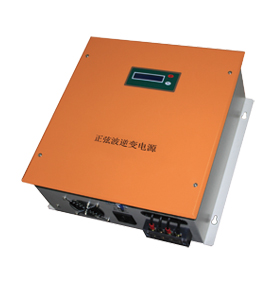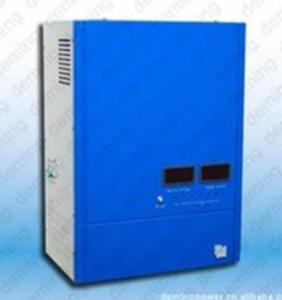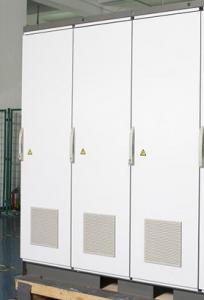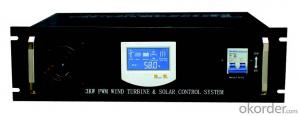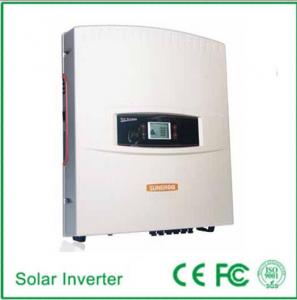Pentair Solar Controllers PV Off-Grid Inverter and Controller Hybrid GN-S0.5K20D
OKorder Service Pledge
OKorder Financial Service
You Might Also Like
Description:
CNBMSOLAR is a world-leading and Vertical integrated manufacturer of high-performance with Silicon,
Wafer, Cells, Modules, which convert sunlight into electricity for residential, commercial, and utility-scale
power generation.
The capacity of CNBMSOLAR is reach to 1GW, and make sure each year our shipment capacity is more
Than 700-800MWs, at the same time, we have set up the largest solar power station with our partner
in Ukraine.
CNBM is a Quality + Service oriented company with“Excellence at Each Step” approach, composed of
the finest components from TUV and IEC-certified partners around the world, CNBM modules consistently
undergo a variety of trials at the company’s Test & Development Centre, ensuring peak performance
capabilities. The company is committed to develop and provide the world with clean and renewable energy
to ease the energy shortages as well as human kind’s impact on the environment.
Data:
Model | GNS-0.5K20D | |
Rated Capacity(KVA) | 0.5 | |
DC Input | Rated Voltage(VDC) | 48 |
Low Voltage(VDC) | 43.2 | |
Low Voltage Resume (VDC) | 52.8 | |
Load Overvoltage(VDC) | 60 | |
Overvoltage Resume(VDC) | 58 | |
PV Input | Rated Current on charging(A) | 20 |
Charge Loop | 1 | |
Overcharge protection(VDC) | 57.6 | |
Overcharge Resumption(VDC) | 56.8 | |
Anti lightning | varistor lighting | |
Grid input | No grid transfer function | |
Rated capacity | Output Waveform | sinewave |
Overload ability | 120% 1min | |
Output voltage(VAC) | 120±3% | |
Output frequency(Hz) | 50±0.04 | |
THD | ≤3℅(THD) | |
Dynamic Response(0~100%) | 5% | |
Efficiency | ≥85% | |
Continous running time | Continuous operation | |
Display | LCD/LED/Meter | |
Protection | Overcharge, overdischarge, overload, short circuit, reverse polarity, internal overheated protections,etc | |
Protection class | IP20 | |
Environment | Noisy | ≤50(dB/m) |
Operating temperature range | -10~+50(℃) | |
Storage temperature range | -25~+55(℃) | |
Operating humidity | 0~95%(non-condensing) | |
Max.altitude(above sea level) | ≤5000(m) | |
Product Dimension (mm) | 400*330*160 | |
Weight(kg) | 21 | |
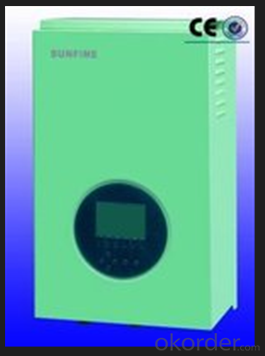
FAQ:Pls introduce more about CNBM
CNBM Group is short for China National Building Materials Group Corporation, which is established in 1984 with approval from the State Council
CNBM Group is the largest comprehensive building materials industry group in China
The Group has a total asset of over RMB 360 billion, more than 180,000 employees and 17 subsidiaries
- Q: Can a solar controller be used in a solar-powered research station in Antarctica?
- Yes, a solar controller can be used in a solar-powered research station in Antarctica. A solar controller regulates and optimizes the charging and discharging of batteries in a solar power system, ensuring efficient energy management. Given the abundant sunlight available in Antarctica during summer months, installing a solar controller would be crucial in maximizing the utilization of solar power and maintaining a stable energy supply for the research station.
- Q: Are solar controllers necessary for small solar systems?
- Yes, solar controllers are necessary for small solar systems. They regulate the flow of electricity from the solar panels to the battery, preventing overcharging and prolonging the battery's lifespan. Additionally, solar controllers help optimize energy efficiency and protect the system from damage caused by excessive voltage or current.
- Q: Can a solar controller be used with sealed batteries?
- Yes, a solar controller can be used with sealed batteries.
- Q: Can a solar controller be used with solar panels of different lifespans?
- Yes, a solar controller can be used with solar panels of different lifespans. The solar controller helps regulate and optimize the charging process of the solar panels, regardless of their individual lifespans. As long as the solar panels are compatible with the solar controller and can generate power, they can be used together.
- Q: How do I choose the right solar controller for my solar panel system?
- To ensure optimal performance and longevity of your solar panel system, it is crucial to choose the right solar controller. Here are some important factors to consider when selecting: 1. System Voltage: Determine the voltage of your solar panels and batteries and find a compatible solar controller. Common voltages include 12V, 24V, and 48V. 2. Maximum Current: Take into account the maximum current generated by your solar panels and select a controller capable of handling that current. Avoid exceeding the controller's maximum current rating to prevent damage. 3. Controller Type: There are three main types of solar controllers: PWM (Pulse Width Modulation), MPPT (Maximum Power Point Tracking), and basic on/off controllers. PWM controllers are suitable for smaller systems, while MPPT controllers are more efficient and recommended for larger systems. 4. Efficiency: Seek a controller with high efficiency ratings to maximize energy harvest from your solar panels, particularly in low light conditions. 5. Load Control: Determine if you need a solar controller that can directly handle loads or if a separate load controller is necessary. Some controllers have built-in load control capabilities, enabling direct power supply to low voltage appliances. 6. Temperature Compensation: If your solar panels will be exposed to varying temperatures, consider a controller with temperature compensation. This feature adjusts charging parameters based on temperature, ensuring optimal charging and battery performance. 7. Protection Features: Ensure the solar controller includes protection features like overcharge, over-discharge, short circuit, and reverse polarity protection. These features safeguard batteries and equipment from damage. 8. Display and Monitoring: Consider controllers with built-in displays for valuable information on system performance and battery status. Some controllers also offer remote monitoring capabilities, allowing you to monitor your system from a distance. 9. Brand Reputation and Warranty: Conduct research on reputable brands known for producing reliable and durable solar controllers. Check warranty information to ensure protection against defects or malfunctions. It is essential to consult with professionals or conduct thorough research before finalizing your decision. They can provide valuable insights and help you select the solar controller that best suits your specific solar panel system requirements.
- Q: How do I protect a solar controller from moisture and humidity?
- There are several steps that can be taken to protect a solar controller from moisture and humidity: 1. Opt for an appropriate location: It is advisable to install the solar controller in a dry and well-ventilated area, away from potential water sources like pipes, leaks, or damp walls. Areas with high humidity levels such as bathrooms or laundry rooms should be avoided. 2. Utilize a weatherproof enclosure: By enclosing the solar controller in a weatherproof enclosure designed for outdoor use with a proper seal, an additional layer of protection against moisture and humidity can be provided. 3. Apply a moisture-resistant coating: To prevent water from seeping into the controller and causing damage, applying a moisture-resistant coating or sealant to the solar controller and its connections is recommended. It is important to use a coating that is compatible with the controller's components and follow the manufacturer's instructions. 4. Maintain proper ventilation: Ensuring that the area where the solar controller is installed has adequate ventilation is crucial to avoid moisture accumulation. This can be accomplished by keeping vents clear and unobstructed. If necessary, the use of a small fan or dehumidifier can help control moisture levels. 5. Conduct regular inspections and cleaning: It is essential to periodically inspect the solar controller for any indications of moisture or humidity damage. Checking for water droplets, condensation, or visible corrosion is important. If any dirt or debris has accumulated, cleaning the controller and its connections with a soft brush or cloth is recommended. By implementing these measures, the risk of moisture and humidity damage to the solar controller can be significantly minimized, ensuring its optimal performance and longevity.
- Q: Can a solar controller be used with a solar-powered electric gate opener?
- Yes, a solar controller can be used with a solar-powered electric gate opener. A solar controller is designed to regulate and optimize the charging and discharging of a solar battery or panel, ensuring the optimal use of solar power. By connecting a solar controller to a solar-powered electric gate opener, it can effectively manage the charging and utilization of solar energy, enhancing the performance and longevity of the gate opener system.
- Q: Can a solar controller be used with a solar-powered outdoor entertainment system?
- Yes, a solar controller can be used with a solar-powered outdoor entertainment system. A solar controller helps regulate the charging and discharging of the batteries connected to the solar panels, ensuring efficient and optimal power management. This is essential for maintaining a stable power supply to the outdoor entertainment system, allowing it to operate effectively even in varying sunlight conditions.
- Q: How do I determine the maximum solar panel input voltage for a solar controller?
- In order to determine the maximum input voltage for a solar controller, one must take into account the specifications of both the solar controller and the solar panels being used. Firstly, it is necessary to consult the datasheet or user manual of the solar controller and locate the maximum input voltage rating provided in the specifications section. This rating signifies the highest voltage that the controller can safely handle without causing any harm or malfunctions. It is imperative to ensure that the voltage of the solar panels does not surpass this maximum input voltage rating. Following that, the open circuit voltage (Voc) of the solar panels must be determined. This refers to the voltage generated by the panels when no load is connected. Typically, this information can be found on the datasheet or product specification of the solar panels. The open circuit voltage of the solar panels should then be compared with the maximum input voltage rating of the solar controller. If the voltage of the solar panels is equal to or below the maximum input voltage rating of the controller, it means that the solar controller can safely handle the panels. However, if the voltage of the solar panels exceeds the maximum input voltage rating of the solar controller, there are a few options available. One option is to utilize a step-down voltage converter or a voltage regulator to reduce the panel voltage to a level that falls within the range supported by the controller. Another option is to consider using a different solar controller with a higher maximum input voltage rating that is capable of handling the voltage of the solar panels. Ultimately, it is crucial to ensure that the voltage of the solar panels falls within the specified limits of the solar controller in order to prevent any damage to the controller and to ensure the optimal performance of the solar power system.
- Q: Can a solar controller be used with solar-powered backpacks?
- Solar-powered backpacks can indeed utilize a solar controller. The primary function of a solar controller is to regulate the voltage and current sourced from the solar panels, ensuring proper battery or device charging. In the context of solar backpacks, employing a solar controller enables efficient energy transfer from the solar panels to either the battery or the electronic devices being charged. This advantageous feature prevents detrimental effects like overcharging, overvoltage, or any other potential issues that may harm the battery or connected devices. Consequently, it is highly advisable to incorporate a solar controller when utilizing solar-powered backpacks to optimize the charging process, as well as guarantee the system's durability and safe operation.
Send your message to us
Pentair Solar Controllers PV Off-Grid Inverter and Controller Hybrid GN-S0.5K20D
OKorder Service Pledge
OKorder Financial Service
Similar products
Hot products
Hot Searches
Related keywords
